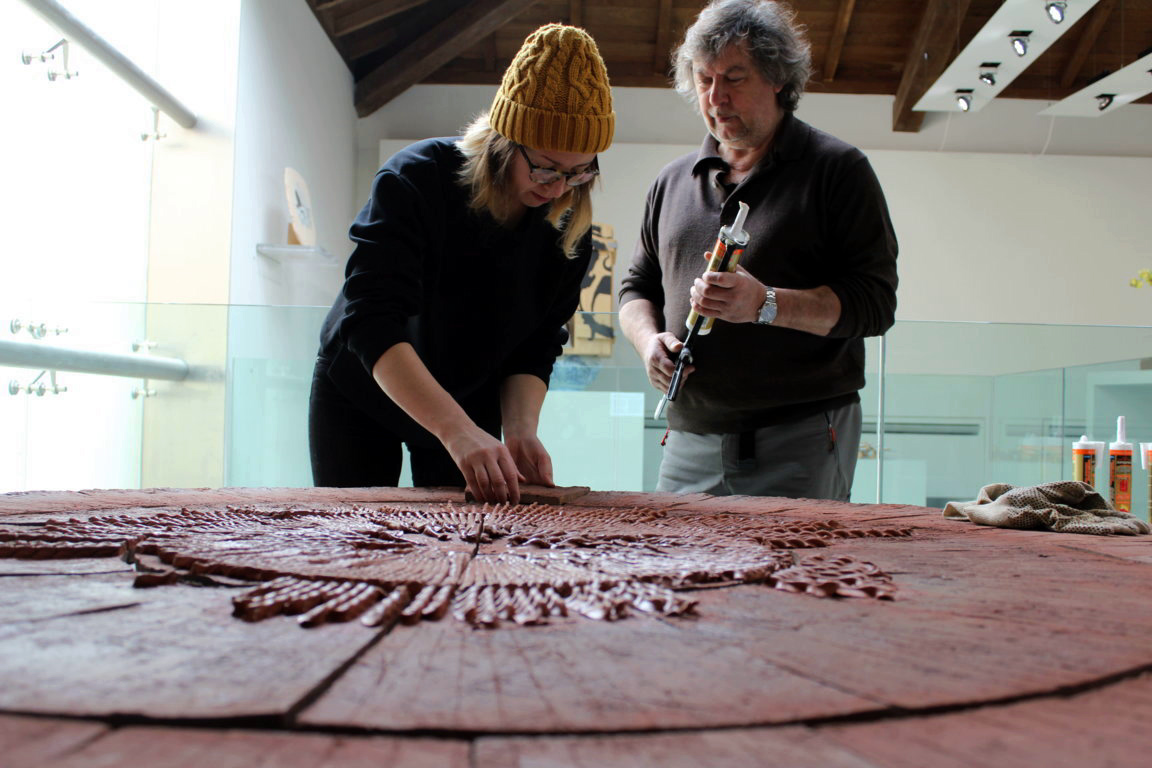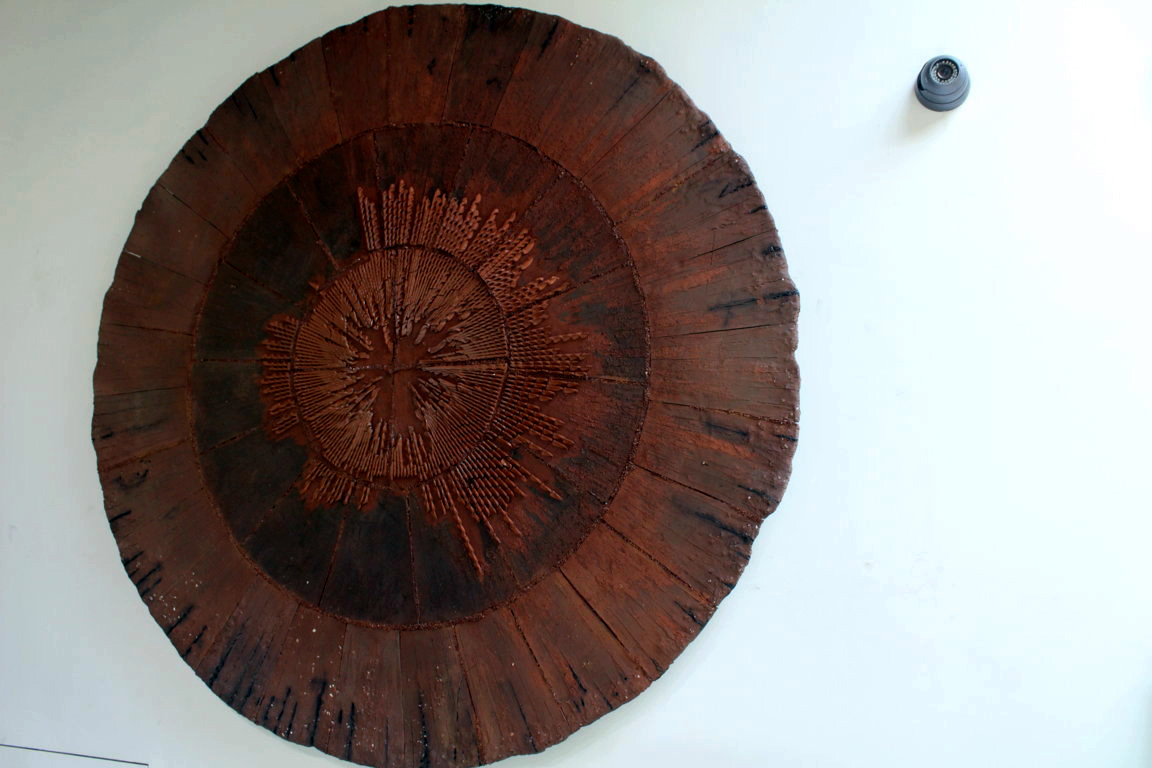The project developed during the Be Sm/ART2 residency, for which I was chosen in early 2017. I was attracted by the opportunity of working with ceramic, a fascinating material that I’d never worked with before, but especially by the great opportunity of working with 3 centres of excellence:
I wanted my work to take shape through cooperation with these extraordinary partners and that for me is the sense of the project. Every reality is reflected in the end work through elements that are inextricably linked, at various levels of interpretation.
The element that links everything is clay, in all its aspects: from its geological formation to its historic heritage in Savona, its influence on the culture of communities past and present, the different manufacturing processes that have been developed, integrated, abandoned and rediscovered through the centuries and, finally, an overall reflection on the concept of using natural resources in the local area in a hyper-industrialised context, in which valorising what is local has been suffocated by global homogenisation.
As the project was obviously ambitious right from the start and as it was created as part of a residency in a few months, time was constantly a challenge. Lack of time definitely led to some very clear choices, to optimising all the stages and abandoning some of the riskier ideas.
I think at the beginning all of us thought we’d make a plate or a vase. The biggest surprise for all of us – me most of all – was the moment in which we realised that to communicate our ideas we had to work on a large scale, horizontally, rather than vertically. This change was only possible due to the great professional skill of Marco Tortarolo and Andrea Graziano and their partners, who accepted the challenge enthusiastically.
I was definitely lucky enough to have found a team of people with a mind-set open to real experimentation and the uncertainties that go with it.

Francesca Perona together with Marco Tortarolo, the ceramist from Albisola who helped her in the making of her work
Despite the fact that I constantly work in a high-tech environment, I’m profoundly connected to the traditional concept of ‘craftsmanship’. There are two thoughts that run parallel in my mind. On one hand, I deeply believe in the value of working materials manually and in the figure of the artisan as the bearer of millennia-old heritage. At the same time, I also believe that new technologies are tools that come to life in an artisan’s hands and revolutionise certain paradigms of manufacturing, and also of aesthetics. There is a ‘digital craftsmanship’ movement that is perfectly represented by our exceptional partners at FabLab in Turin, who use mathematics and code to control the robotic arm, but at the same time a hammer and screwdriver to constantly adjust the robot’s output. However, there is still a traditional movement of artisans who use chisels, lathes and their hands to create objects that have a primordial gestural expressiveness.
For me the fundamental question is ‘how can I valorise both approaches’? What room is there for traditional craftsmanship in the so-called digital revolution? All in all, our project tries to (begin to) answer this question. This is why a lot of work on the piece is the result of manual knowledge of material. At the same time, the robotic arm was used to maximise the malleability of the material and its ability to assume and maintain intricate shapes that were difficult to produce by hand and, above all, which could be endlessly reproduced, given that these machines can repeat the same identical gesture with the same identical output each time, based on a numerical code. I focussed on using a set of data for the digital aspect of the work so that I could underline the relationship between data and shape.

A detail of the rays crafted with the robotic arm in the Savona Campus of the University of Genoa
The Department of Engineering’s work is extremely interesting. The Savona University Campus is run like a little Smart City, powered by renewable energy. The aim of the researchers is to create a system independent of the National Grid to meet all the energy needs of the Campus. The concept of independent resources is extremely modern and, at the same time, extremely ancient. In digital manufacturing there is a new line of thought that wants to decentralise production and return it to the hands of citizens. However, this also means decentralising resources and going back to looking around ourselves, to what is locally produced, and rediscovering what resources are present in the local area that can be exploited through new technological processes. This is another way to interpret the Ceramica per l’Antropocene project.
For this and other reasons, what we did with the engineers was to analyse all the data gathered in 2016 on renewable energy production and the use of national energy resources by comparison. The result was projected onto the work, which became a graph to accurately represent the proportions of independence and dependence on local and international energy sources.
Ah, that’s a great question. Overall, I’m extremely satisfied with the result.
If I had to do it again, there are little things that I’d change, like some aspects of how the data is represented and I’d also like to experiment more with the irregular border of the work, the layers of grog and its three-dimensionality. At a certain point of the project I imagined laying this large shape on a concave mould, and creating an end shape that still had a round base but that developed upwards, almost like a volcano. Due to technical reasons and time constraints we weren’t able to create these aspects.

Francesca Perona’s work installed in its final position
Ceramica per l’Antropocene was my most challenging project up to now, but also perhaps the most fun. I was lucky to meet incredibly empathetic and cultured local people, who completely understood my way of working and didn’t say no to anything, no matter how absurd. I think that for a lot of people involved in the project this was a both a journey into the past and future. We made a lot of little road trips in many areas around Savona and Albisola, as far as a small village in the middle of nowhere above Albenga, to discover people and places. We saw the wealth of beauty of Liguria and plunged our hands and feet into local clay. We explored the material in all its forms and tried out an incredible range of techniques and shapes. We discussed the meaning of the material’s expressive nature, from the point of view of art, craftsmanship, engineering and technology. I couldn’t have asked for more.
I’m really happy to be back because I have an excellent relationship with the local area, where some great friendships began. I’d stay here longer if I could!
I didn’t know the area, but in the months of the residency I embarked on almost anthropological research to understand the history of ceramic and the local area and how they shaped each other. I asked all the project partners a lot of questions, and absorbed everything that could be useful for the development of the work.
I’d also never worked with ceramic, but professionally I have a visceral passion for materials and for the need to understand them and use them in new contexts. My background is totally in textiles but over time I’ve done in-depth research into materials in various fields and tried a range of applications and technologies.
I found ceramic a fascinating material in all senses: from its geological and chemical source to the shapes it takes on as a result of its plasticity, transforming from something soft and malleable into a fragile rigidity, the way it breathes when it changes temperature and all the issues related to its continual transformation.
Every material has its constraints. In the case of ceramic, I think it’s very difficult to get around these constraints without the advice of an artisan. Only someone who has known the material so intimately can prevent potential problems. And it is only thanks to Marco Tortarolo that we managed to achieve these results, without breaking any pieces during baking.
Let’s just say that we went looking for particularly difficult tasks, having chosen to work on an imposing scale for a first work and to refine ‘natural’ local clays by hand, without any guarantee of how they would behave in the kiln.
However, I’d say that we managed brilliantly to respect and valorise all the moods and shades of the material and to push it to the limits of its possibilities. This is obviously only thanks to all the work on preparing the material and the number of samples that we did. From 6 materials collected at the start in the Savona area, we produced a minimum of a hundred mixtures and variations and only the tiniest part of these were used in the final work.
Francesca Perona was born in 1986. She lives in London where she works as a designer and researcher. Her inter/transdisciplinary approach to research aims to combine the science of materials, scientific processes and digital manufacturing techniques. She is interested in the behaviour of materials in science, technology, art, culture and the environment, an approach that allows her to study innovative design practices based on sustainability and creativity.
Take a look to the other interviews